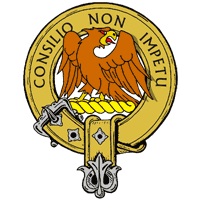
Clan Agnew
The ancestry of the name Agnew is not unusual in that it appears to have two possible sources; The most accepted version is that the name is French in origin, coming from the Barony d'Agneaux in Normandy who settled first in England and then migrated north to Liddesdale around the 12th century. The other possibility is that they were connected to one of the tribes of Ulster, maybe as a sept of of O'Gnimh (pronounced O'New). This name would have gone through many variations; O'Gnive, O'Gnyw, MacGnive, and finally Agnew. This version of events would relate Agnew to Somerled and the Lords of the Isles (clan Donald). Indeed many Agnews are found in Ireland so there may be some truth in this theory. Reliable records begin in the 12th Century when Sir John de Courcy was accompanied by Agneau, an Anglo-Norman knight who was witness to a borders charter between Ranulf de Soulis and Jedburgh Abbey. The Agnews of Lochnaw were appointed sheriffs of Galloway by David II In 1363 and rose to power in this area. In 1375 The Agnew Lord of Larne accompanied Edward Bruce, younger brother of King Robert the Bruce to Ireland where he had been invited by the Irish Lords to help rid them of the English and rule in their place. Agnew stayed with Edward for three years while he attempted to establish his power. In 1426 Andrew Agnew was appointed Constable of Lochnaw Castle. and later in 1451, Sheriff of Wigtown. His great grandson Patrick Agnew, was a contemporary of of Queen Mary and James VI. While the Agnews rise to power in the south west of Scotland had been under the Douglasses when this clan fell from the Kings favour the Agnews in Galloway in fact benefited. However this then brought them into conflict with the MacKies and MacClellans. Patrick Agnew's son was 7th Sheriff of Wigton and was created a baronet of Nova Scotia by Charles I. His son, Andrew was MP for Wigtounshire and was knighted and created Sheriff of Kirkcudbright. He married Anne Stewart, daughter of the first Earl of Galloway. Sir Andrew, the fifth Baronet commanded the 21st Foot, (Scots Fusiliers) at the Battle of Dettingen in June 1743, the last time a British monarch, George II, commanded troops in person. Sir Andrew held Blair Castle against the forces of Prince Charles Edward Stuart, led by Lord George Murray in 1746. The garrison had been virtually starved out when Murray was called away to tackle the approaching Cumberland. The present chief of the name and family of Agnew is Sir Crispin Agnew of Lochnaw. Sir Crispin is the appointed Rothesay Herald at the Court of the Lord Lyon King of Arms. Lochnaw Castle near Stranraer was bought by an Australian Miss Del Agnew in the 1950's and is now run for the trust.








